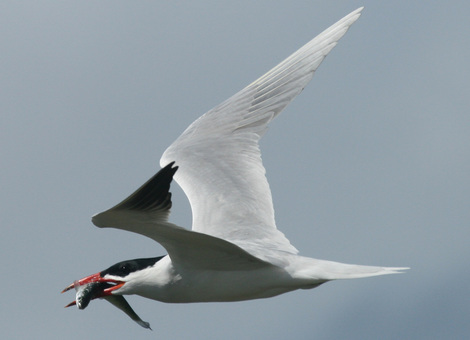|
Once upon a time, I used to live on a small dredge spoil island at the mouth of the Columbia River. Located within view of beautiful Astoria, Oregon - home of The Goonies and the location of Lewis and Clark's encampment on the Pacific- this small island was an astonishing location for breeding colonies of Caspian terns and double crested cormorants. Given the outflow of millions of salmonid smolts and the proximity to saltwater fish, the piscivorous birds thrived. I lived on the island for a breeding season, spending hours in the bird blinds cataloging diet composition, breeding phenology and colony size. To have opportunity to observe the crescendo and rhythm of breeding season provided an incredibly intimate perspective into a remarkable biological phenomenon and was a formative experience in my fledgling career. Recently, this same island has become the subject of some intense controversy given a proposal to kill thousands of cormorants in an effort to maintain salmonid stocks. This news has caused me to reflect on my own experiences on the island and compelled me to repost a piece that I wrote several years ago while in the midst of a field season on the island. The Caspian tern was seemingly engineered for two specific purposes:
1) Flying and 2) Eating fish. Ostensibly, these two purposes are not mutually exclusive and clearly terns can do other things quite well- mating or making loud noises (or making loud noises while mating)- but when it comes down to the essentials, the nuts and bolts, terns were most poetically and endearingly built to fly and consume fish. Let’s start with the first purpose: flying. My favorite purpose. Terns grace the skies not with the frantic, staccato wing beats of a mallard or the deep, powerful flaps of a bald eagle, but rather with elegant waves of their sharply tapered wings- the way I imagine seraphim travel the heavens. The flight of a tern is spectacularly effortless, forcing the casual observer to wonder how they stay aloft. Master’s of the wind, they carve and slice their Aeolian environ, riding breezes that scarcely rustle a blade of grass. Engineers or academics of biomechanics might attribute this mastery of flight to high aspect ratio wings or rigid primary feathers, but that empirical explanation does little to capture the sheer poetry of their graceful movements. The second purpose requires a bit of understanding and observation to fully appreciate. All birds eat to sustain themselves - it’s true- but few have made such an impression on me. This realization is perhaps a direct result of me observing tern bill-load contents for three hours every day for the past four months, but I doubt it. H. caspia is remarkably adept at the art of avian fishery. They glide and hover, gently articulating their necks as they glance down to scan the surface of the water. Upon recognition of their target, they fold and dive like a feathered lance, extending their necks forward and wings backwards as they pierce the surface. Be it a Clupeid or Embiotocid, anchovy or salmonid, the Caspian tern is supremely adapted to capture and consume. Given my deep appreciation for this splendid bird, I don’t fancy the name “Caspian Tern.” For a bird that ranges over six continents and forages in innumerable watersheds , that name seems myopically inadequate. Nor does the Linnaean nomenclature of Hydroprognes caspia do the poetry of this magnificent and rambunctious tern any justice. I hereby propose a new regal and majestic label; one that perfectly encapsulates the Caspian tern’s anthropomorphized persona in onomatopoeia-tic form: Aaayayaumsaurus Rex (the call of the Caspian tern as described by the Ornitholo-prophet David Sibley). As I conclude my treatise, dear reader, please forgive me my rather lengthy and obtuse prose. Indeed it is true that at times I inadvertently utilize vocabulary with an inordinate abundance of syllables; however I wish only to convey my unending amazement of this spectacular organism. But seriously, Caspian terns are wicked sweet birds. They’re pretty much super awesome.
1 Comment
Leave a Reply. |
AuthorMichael Brown Archives
December 2022
Categories |


 RSS Feed
RSS Feed
